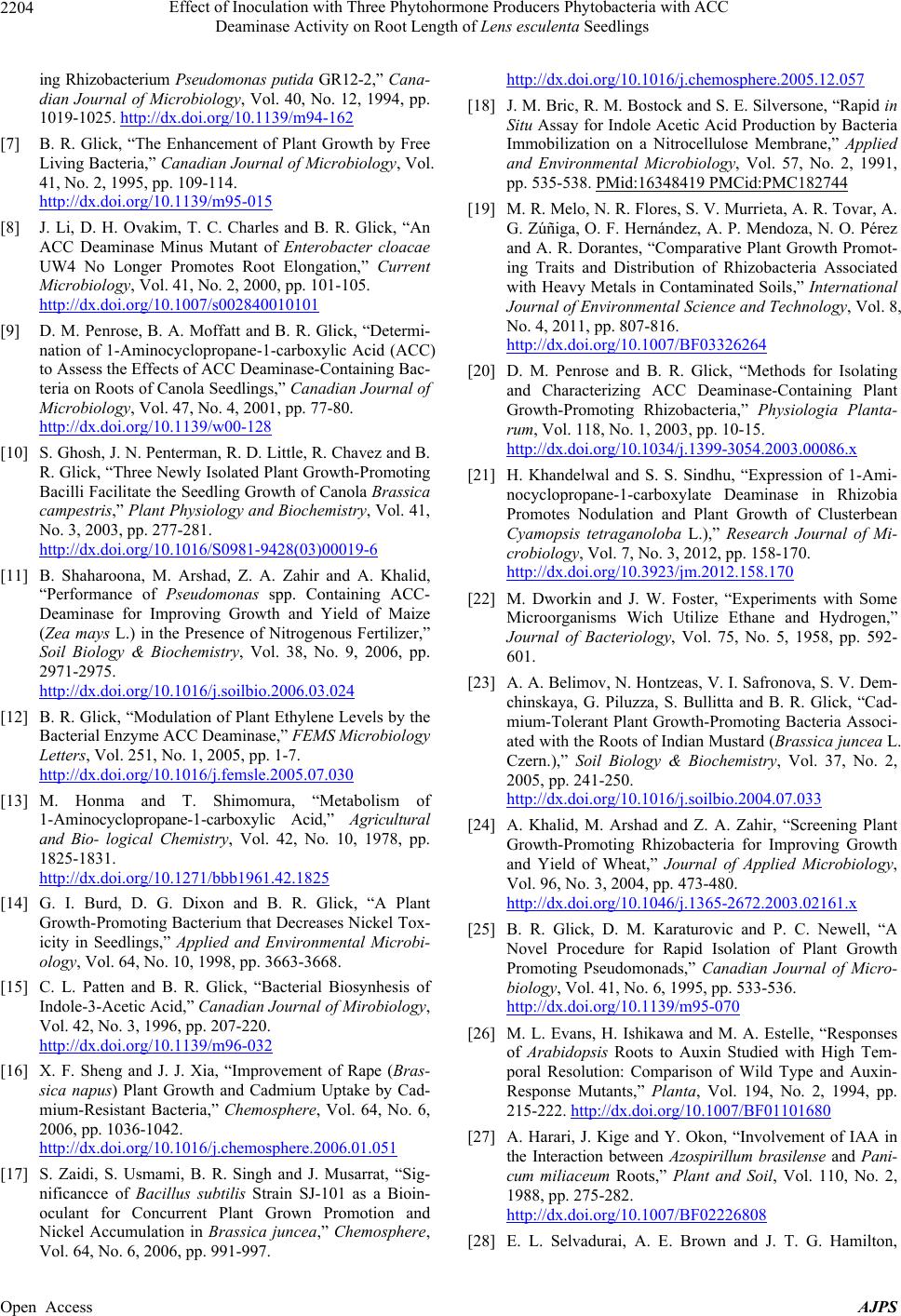
Effect of Inoculation with Three Phytohormone Producers Phytobacteria with ACC
Deaminase Activity on Root Length of Lens esculenta Seedlings
2204
ing Rhizobacterium Pseudomonas putida GR12-2,” Cana-
dian Journal of Microbiology, Vol. 40, No. 12, 1994, pp.
1019-1025. http://dx.doi.org/10.1139/m94-162
[7] B. R. Glick, “The Enhancement of Plant Growth by Free
Living Bacteria,” Canadian Journal of Microbiology, Vol.
41, No. 2, 1995, pp. 109-114.
http://dx.doi.org/10.1139/m95-015
[8] J. Li, D. H. Ovakim, T. C. Charles and B. R. Glick, “An
ACC Deaminase Minus Mutant of Enterobacter cloacae
UW4 No Longer Promotes Root Elongation,” Current
Microbiology, Vol. 41, No. 2, 2000, pp. 101-105.
http://dx.doi.org/10.1007/s002840010101
[9] D. M. Penrose, B. A. Moffatt and B. R. Glick, “Determi-
nation of 1-Aminocyclopropane-1-carboxylic Acid (ACC)
to Assess the Effects of ACC Deaminase-Containing Bac-
teria on Roots of Canola Seedlings,” Canadian Journal of
Microbiology, Vol. 47, No. 4, 2001, pp. 77-80.
http://dx.doi.org/10.1139/w00-128
[10] S. Ghosh, J. N. Penterman, R. D. Little, R. Chavez and B.
R. Glick, “Three Newly Isolated Plant Growth-Promoting
Bacilli Facilitate the Seedling Growth of Canola Brassica
campestris,” Plant Physiology and Biochemistry, Vol. 41,
No. 3, 2003, pp. 277-281.
http://dx.doi.org/10.1016/S0981-9428(03)00019-6
[11] B. Shaharoona, M. Arshad, Z. A. Zahir and A. Khalid,
“Performance of Pseudomonas spp. Containing ACC-
Deaminase for Improving Growth and Yield of Maize
(Zea mays L.) in the Presence of Nitrogenous Fertilizer,”
Soil Biology & Biochemistry, Vol. 38, No. 9, 2006, pp.
2971-2975.
http://dx.doi.org/10.1016/j.soilbio.2006.03.024
[12] B. R. Glick, “Modulation of Plant Ethylene Levels by the
Bacterial Enzyme ACC Deaminase,” FEMS Microbiology
Letters, Vol. 251, No. 1, 2005, pp. 1-7.
http://dx.doi.org/10.1016/j.femsle.2005.07.030
[13] M. Honma and T. Shimomura, “Metabolism of
1-Aminocyclopropane-1-carboxylic Acid,” Agricultural
and Bio- logical Chemistry, Vol. 42, No. 10, 1978, pp.
1825-1831.
http://dx.doi.org/10.1271/bbb1961.42.1825
[14] G. I. Burd, D. G. Dixon and B. R. Glick, “A Plant
Growth-Promoting Bacterium that Decreases Nickel Tox-
icity in Seedlings,” Applied and Environmental Microbi-
ology, Vol. 64, No. 10, 1998, pp. 3663-3668.
[15] C. L. Patten and B. R. Glick, “Bacterial Biosynhesis of
Indole-3-Acetic Acid,” Canadian Journal of Mirobiology,
Vol. 42, No. 3, 1996, pp. 207-220.
http://dx.doi.org/10.1139/m96-032
[16] X. F. Sheng and J. J. Xia, “Improvement of Rape (Bras-
sica napus) Plant Growth and Cadmium Uptake by Cad-
mium-Resistant Bacteria,” Chemosphere, Vol. 64, No. 6,
2006, pp. 1036-1042.
http://dx.doi.org/10.1016/j.chemosphere.2006.01.051
[17] S. Zaidi, S. Usmami, B. R. Singh and J. Musarrat, “Sig-
nificancce of Bacillus subtilis Strain SJ-101 as a Bioin-
oculant for Concurrent Plant Grown Promotion and
Nickel Accumulation in Brassica juncea,” Chemosphere,
Vol. 64, No. 6, 2006, pp. 991-997.
http://dx.doi.org/10.1016/j.chemosphere.2005.12.057
[18] J. M. Bric, R. M. Bostock and S. E. Silversone, “Rapid in
Situ Assay for Indole Acetic Acid Production by Bacteria
Immobilization on a Nitrocellulose Membrane,” Applied
and Environmental Microbiology, Vol. 57, No. 2, 1991,
pp. 535-538. PMid:16348419 PMCid:PMC182744
[19] M. R. Melo, N. R. Flores, S. V. Murrieta, A. R. Tovar, A.
G. Zúñiga, O. F. Hernández, A. P. Mendoza, N. O. Pérez
and A. R. Dorantes, “Comparative Plant Growth Promot-
ing Traits and Distribution of Rhizobacteria Associated
with Heavy Metals in Contaminated Soils,” International
Journal of Environmental Science and Technology, Vol. 8,
No. 4, 2011, pp. 807-816.
http://dx.doi.org/10.1007/BF03326264
[20] D. M. Penrose and B. R. Glick, “Methods for Isolating
and Characterizing ACC Deaminase-Containing Plant
Growth-Promoting Rhizobacteria,” Physiologia Planta-
rum, Vol. 118, No. 1, 2003, pp. 10-15.
http://dx.doi.org/10.1034/j.1399-3054.2003.00086.x
[21] H. Khandelwal and S. S. Sindhu, “Expression of 1-Ami-
nocyclopropane-1-carboxylate Deaminase in Rhizobia
Promotes Nodulation and Plant Growth of Clusterbean
Cyamopsis tetraganoloba L.),” Research Journal of Mi-
crobiology, Vol. 7, No. 3, 2012, pp. 158-170.
http://dx.doi.org/10.3923/jm.2012.158.170
[22] M. Dworkin and J. W. Foster, “Experiments with Some
Microorganisms Wich Utilize Ethane and Hydrogen,”
Journal of Bacteriology, Vol. 75, No. 5, 1958, pp. 592-
601.
[23] A. A. Belimov, N. Hontzeas, V. I. Safronova, S. V. Dem-
chinskaya, G. Piluzza, S. Bullitta and B. R. Glick, “Cad-
mium-Tolerant Plant Growth-Promoting Bacteria Associ-
ated with the Roots of Indian Mustard (Brassica juncea L.
Czern.),” Soil Biology & Biochemistry, Vol. 37, No. 2,
2005, pp. 241-250.
http://dx.doi.org/10.1016/j.soilbio.2004.07.033
[24] A. Khalid, M. Arshad and Z. A. Zahir, “Screening Plant
Growth-Promoting Rhizobacteria for Improving Growth
and Yield of Wheat,” Journal of Applied Microbiology,
Vol. 96, No. 3, 2004, pp. 473-480.
http://dx.doi.org/10.1046/j.1365-2672.2003.02161.x
[25] B. R. Glick, D. M. Karaturovic and P. C. Newell, “A
Novel Procedure for Rapid Isolation of Plant Growth
Promoting Pseudomonads,” Canadian Journal of Micro-
biology, Vol. 41, No. 6, 1995, pp. 533-536.
http://dx.doi.org/10.1139/m95-070
[26] M. L. Evans, H. Ishikawa and M. A. Estelle, “Responses
of Arabidopsis Roots to Auxin Studied with High Tem-
poral Resolution: Comparison of Wild Type and Auxin-
Response Mutants,” Planta, Vol. 194, No. 2, 1994, pp.
215-222. http://dx.doi.org/10.1007/BF01101680
[27] A. Harari, J. Kige and Y. Okon, “Involvement of IAA in
the Interaction between Azospirillum brasilense and Pani-
cum miliaceum Roots,” Plant and Soil, Vol. 110, No. 2,
1988, pp. 275-282.
http://dx.doi.org/10.1007/BF02226808
[28] E. L. Selvadurai, A. E. Brown and J. T. G. Hamilton,
Open Access AJPS